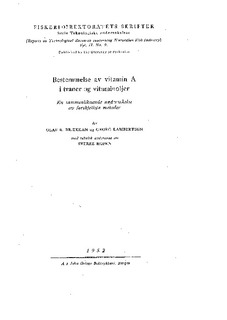| dc.description.abstract | Since the World Health Organizations subcomittee on Fat-Soluble Vitamins published their recommendations for the determination of vitamin A (21), new methods based on their recommendations have been adopted by U.S.P. XIV (6) and B.P. Add.-51 (7). The present paper reports results from the investigation of the effects of these new methods on the evaluation of the vitamin A potency of fish liver oils. Further there have been included applications of the recently published corretion equations of Cama et al. (14) and estimations according to the chromatographic procedure of Gridgeman (18). 35 samples of commercial Norwegian fish liver oils and vitamin A concentrates have been analysed according to these methods, and the results are summarized in Tables 1-5. Since these data speak largely for themselves, only brief explanations and comments are given. The determination according to the WHO's method were carried out in ethanol, and the correction procedure of Morton & Stubbs (2) was applied to the absorption curves. The results show
E (1%)/1cm (325mµ)-values agreeing within ± 3 % before application of corrections, compared to ± 12% after. The corresponding figures for the U.S.P. XIV method were respectively ± 2 % and ± 6 %, and for the B.P. Add.-51 method ± 2,5 % and ± 15 %. These figures are in agreement with other reports from applications of the respective methods (10, 11, 19)] When compared with the E-values from the chromatographic method, all the differently corrected E-values are lower. This is particularly the case were the correction equations are built on the new curves for all-trans-vitamin A (Cama et al., U.S.P. XIV, and B.P. Add.-51) The B.P. Add.-51 values of the unsaponifiable matter give a mean which is only 81% of the >>Gridgeman values<<. This is obviously partly caused by the lower E (1%)/1cm (max)-value of vitamin A in cyclohexane, cm 1750, compared to ca. 1850 in ethanol and isopropanol (22, 23). The authors regret that the subcomitee did not consider the problem of solvent versus conversion factor in their recommendations. Further work with chromatographic procedures for the estimation of vitamin A are at present in progress at this laboratory. | en |
